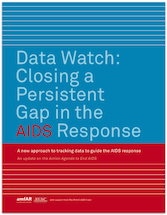- About UsOur Story, Our Team & Support Information
- What We DoAdvocacy to Achieve the End of AIDS
- Advance HIV/SRH Integration
- Advocate for Access to High-Impact Prevention
- Improve Research Conduct
- Product Innovation & Availability
- Promote Effective HIV Prevention Policy
- Strengthen Global Advocacy Networks
- Track and Translate the Field
- Our FocusInterventions to End the Epidemic
- ResourcesPublications, Infographics, Events & More
- MediaInformation & Resources for the Press
- Our BlogPrevention News & Perspective
top
August 18, 2014
Contacts
AVAC: Kay Marshall, kay@avac.org, +1-347-249-6375
Mitchell Warren, mitchell@avac.org, +1-914-661-1536
amfAR: Joana Casas, joana.casas@amfar.org, +1-212-806-1602
amfAR and AVAC call for improved, transparent and timely data collection

New York – A new report from amfAR, The Foundation for AIDS Research, and AVAC outlines the need for a new approach to tracking data to guide the key decisions that shape the response to the HIV/AIDS epidemic. Critical and expensive decisions made with incomplete data are undermining the response—even as the systems for collecting this data continue to improve, the report found. Data Watch: Closing a Persistent Gap in the AIDS Response outlines corrective steps to sustain and expand the progress made in the past few years in the AIDS response and lays out key areas where better, more complete data is needed, including:
- What proportion of people with HIV globally who are taking antiretroviral drugs remain connected to a clinical provider and have their virus fully suppressed, enabling them to remain healthy and avoid transmitting HIV to others?
- What proportions of those communities most impacted by HIV (e.g., young women in Africa, gay men and other men who have sex with men, transgender individuals, sex workers, people who inject drugs) do not have access to effective HIV prevention tools due to pervasive stigma or discrimination?
- Is global AIDS funding focused on those programs that will have the greatest impact in reducing transmission and disease burden worldwide?
The report, supported in part by the M•A•C AIDS Fund, makes the case that if we are to achieve ambitious new targets aimed at ending the epidemic by 2030, we must improve our data systems for the HIV response now. Data Watch updates amfAR’s and AVAC’s 2012 Action Agenda to End AIDS, which made the case for a more businesslike approach to ending the epidemic and proposed a multi-year plan with concrete strategies, targets and timelines.
“There is no doubt that the data we have shows that we are making progress in the fight against HIV/AIDS. Importantly, we are moving toward a ‘tipping point,’ when for the first time the number of people with access to HIV treatment will exceed the number of people who become infected,” said Mitchell Warren, AVAC executive director. “But to keep up the momentum, we must improve data systems and identify specific milestones that we need to meet over the next one to three years to ensure we get on – and stay on – target to achieve these ambitious goals.”
The report documents many cases where data is incomplete or missing, finding that sometimes necessary data collection systems are not in place. For example, in most low- and middle- income countries there is very little tracking of viral load—a measure of the amount of HIV in a person’s bloodstream—among people being treated for HIV. In many cases, data exists but is incomplete or not being optimally analyzed. Poor or missing data limits our ability to drive strategic action and accelerate progress toward ending AIDS.
“Good information is critical for making good decisions, and when resources are limited, data matters even more,” said Greg Millett, amfAR’s vice president and director of public policy. “With global AIDS funding falling far short of what is needed, we must maximize the impact of every dollar. The bottom line is clear: more complete and timely data will help save more lives.”
The report calls on UNAIDS, the US-funded PEPFAR program, and the Global Fund to Fight AIDS, Tuberculosis and Malaria to dramatically improve their collection, analysis and reporting of HIV/AIDS information. It outlines which data matters the most, including:
- Coverage of core interventions including HIV testing, antiretroviral therapy, voluntary medical male circumcision, prevention of vertical transmission, male and female condom availability, and harm reduction programs.
- Disaggregated information by gender, age, key population status, and other key factors. Overall numbers are insufficient.
- Indicators of service quality including percentage of people on ART with undetectable viral load tests, retention in care data and more.
- Impact data on incidence, HIV prevalence and AIDS-related deaths are the ultimate indicators of success.
- Results-linked expenditure data sheds light on where programs are achieving results and on how reallocation of resources could improve program impact.
As part of the Action Agenda to End AIDS, amfAR and AVAC launched Data Watch to help advocates track progress—and to hold the key sources of global HIV information accountable for timely, accurate reports. An Action Agenda to End AIDS, launched by amfAR and AVAC at the 2012 International AIDS Conference, outlined key actions that need to be taken in 2012–2016 to lay the foundation to end the AIDS pandemic. For more information, visit endingaids.org.
###
About amfAR: amfAR, The Foundation for AIDS Research, is one of the world’s leading nonprofit organizations dedicated to the support of AIDS research, HIV prevention, treatment education, and the advocacy of sound AIDS-related public policy. Since 1985, amfAR has invested more than $388 million in its programs and has awarded more than 3,300 grants to research teams worldwide.
About AVAC: Founded in 1995, AVAC is a non-profit organization that uses education, policy analysis, advocacy and a network of global collaborations to accelerate the ethical development and global delivery of AIDS vaccines, male circumcision, microbicides, PrEP and other emerging HIV prevention options as part of a comprehensive response to the pandemic.